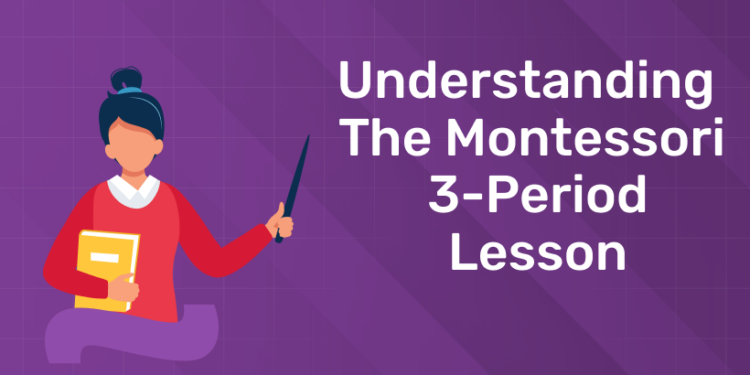Table of Contents
The Montessori method is renowned for its child-centered approach to education. The 3-Period lesson is one of the most effective strategies applied widely in Montessori classrooms. This helps the children to grasp language, math and sensory skills with clarity. In this blog, we’ll understand how the Montessori 3-Period lesson works, when to use it, what are the materials involved, and the key benefits it offers in a child’s development.
Start your journey to becoming a certified Montessori teacher! Get free Demo Here!
What is Montessori 3-Period Lesson?
The Montessori 3-Period Lesson is a teaching technique used to introduce and reinforce new concepts, vocabulary, and skills in a clear and structured way. It consists of three stages:
1. Introduction (Naming) – “This is…”
The teacher presents the object or concept and names it.
Example: Showing a red ball and saying, “This is red.”
2. Recognition (Association) – “Show me…”
After introducing the concept or object, the teacher asks the child to identify it, either by pointing to it or handling it.
Example: “Show me red.” (The child points to or picks up the red ball.)
3. Recall (Confirmation) – “What is this?”
The teacher asks the child to recall the name independently.
Example: Holding up the red ball and asking, “What color is this?” (The child answers, “Red.”)
When to Use the 3-Period Lesson?
1: What is the primary focus of the first plane of development in the Montessori method?
The Montessori 3-Period Lesson is best used when introducing new vocabulary, concepts, or skills in a clear and structured way. It is highly effective for young children, but can be adapted to for older ones as well. Here’s when to use it:
1. Teaching New Vocabulary
This method is effective in introducing colors, shapes, numbers, letters, and names of objects.
Example: Introducing geometric solids like “cube,” “sphere,” and “cone.”
2. Checking for Understanding & Mastery
Before moving on to a more advanced lesson. To assess if a child can recall and apply knowledge independently.
3. Supporting Individualized Learning
With younger children or beginners who need a slow and clear introduction.
With children who need extra reinforcement before progressing.
4. Language Development
The 3-Period Lesson makes it easy for children to comprehend vocabulary and pronunciation. They are the important aspects in language development.
Example: Teaching names of animals, body parts, or objects in a new language.
5. Cultural and Practical Life Activities
Naming different tools, utensils, or materials used in daily life.
Example: Teaching “spoon,” “fork,” and “knife” in a practical life lesson.
Get Certified & Start Your Montessori Career
Montessori Teacher Training Course by Entri App: Gain expert skills, earn certification, and kickstart your teaching career.
Join Now!Materials Used in the 3-Period Lesson
The materials used in the Montessori 3-Period Lesson depend on the concept being introduced. Here are some common materials:
1. Language Development
Object cards & real objects (e.g., miniature animals, fruits, household items)
Sandpaper letters (for phonetic sounds)
Picture cards (for vocabulary building)
2. Math Concepts
Number rods (to introduce quantities)
Spindle boxes (to associate numbers with quantities)
Beads & counters (for counting and operations)
3. Sensorial Learning
Color tablets (for learning color names)
Geometric solids (for shape recognition)
Sound cylinders (for distinguishing sounds)
4. Science & Geography
Land and water form trays (to learn geographic features)
Botany puzzles (to identify parts of plants)
Animal classification cards (for learning about different species)
5. Practical Life Activities
Real-life objects (e.g., spoon, fork, cup, brush)
Dressing frames (for learning to button, zip, and tie)
The key is to use simple, clear, and tactile materials that allow children to engage in active learning.
Benefits of the 3-Period Lesson
The Montessori 3-Period Lesson is highly beneficial for a child’s learning and development. Here are some key advantages:
1. Clear and Structured Learning
Breaks down new concepts into simple, manageable steps.
Helps children absorb information in a logical and sequential way.
2. Active and Engaged Learning
Encourages participation and keeps children hooked in the learning process.
3. Strengthens Memory and Recall
Reinforces knowledge through repetition and interaction.
Helps children retain information for long-term learning.
4. Builds Confidence and Independence
Children are able to learn at their own pace.
They get the opportunity to self-correct and gain mastery.
5. Encourages Observation and Focus
Develops attention to detail through careful listening and responding.
Enhances concentration and observation skills.
6. Supports Language and Communication Skills
Expands vocabulary and improves pronunciation.
Encourages verbal expression and active listening.
7. Adaptable to Different Subjects
Can be used for teaching language, math, science, geography, and practical life skills.
Works for all age groups and learning levels.
Conclusion
The Montessori 3-Period Lesson is a simple and effective method for introducing new concepts, vocabulary, and skills in a structured yet engaging way. By breaking the information into three clear stages—naming, recognition, and recall—this method supports children’s natural curiosity and helps them confidently absorb and retain knowledge.
This method can be used for language, math, sensorial learning, or practical life skills. It is a powerful tool for both educators and tutors in supporting a child’s natural curiosity and cognitive development.
By incorporating this method into daily learning, we can create an environment where children not only absorb knowledge but also develop a lifelong love for learning.
Start your journey to becoming a certified Montessori teacher! Get free Demo Here!
FAQs: Understanding the Montessori 3-Period Lesson
1. What is the Montessori 3-Period Lesson?
The Montessori 3-Period Lesson is a structured teaching technique used to introduce new concepts, vocabulary, and skills. It consists of three stages: naming, recognition, and recall.
2. What age group is the 3-Period Lesson suitable for?
This method is primarily used for children in the early childhood (ages 2.5 to 6) stage but can be used for older children as well.
3. What subjects can be taught using the 3-Period Lesson?
This method can be applied to language, math, sensorial learning, science, geography, and practical life activities.
4. How long should a 3-Period Lesson last?
The lesson can typically last 5 to 10 minutes. It should be short and engaging, depending on the child’s attention span and interest.
5. What materials are used in a 3-Period Lesson?
The different materials commonly used in a 3-Period Lesson are real-life objects, picture cards, number rods, color tablets, geometric solids, and landform models, etc depending on the topic being taught.
6. Is the 3-Period Lesson only for Montessori education?
No, even though the 3-Period Lesson is a key Montessori method, it can be used in any educational setting to support structured and interactive learning.











